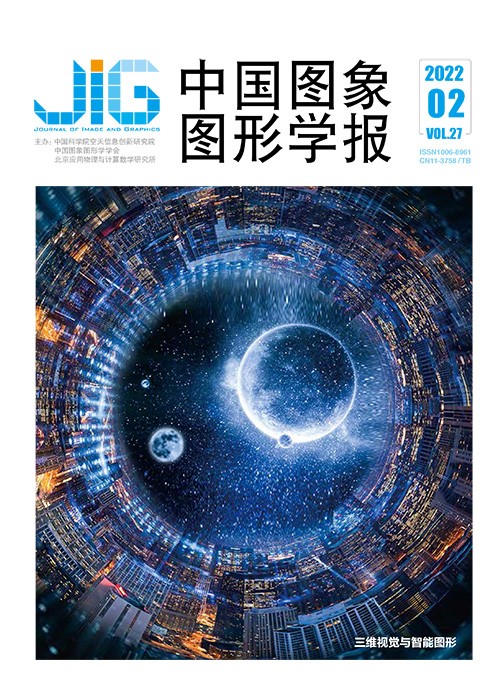
深度学习刚性点云配准前沿进展
摘 要
随着3维采集设备的日渐推广,点云配准在越来越多的领域得到应用。然而,传统方法在低重叠、大量噪声、多异常点和大场景等方面表现不佳,这限制了点云配准在真实场景中的应用。面对传统方法的局限性,结合深度学习技术的点云配准方法开始出现,本文将这种方法称为深度点云配准,并对深度点云配准方法研究进展予以综述。首先,根据有无对应关系对目前的深度学习点云配准方法进行区分,分为无对应关系配准和基于对应关系的点云配准。针对基于对应关系的配准,根据各类方法的主要功能进行详细的分类与总结,其中包括几何特征提取、关键点检测、点对离群值去除、姿态估计和端到端配准,并重点介绍了最新出现的一些方法;针对无对应配准方法,详细介绍了各类方法的特点并对无对应与有对应方法的特点进行了总结。在性能评估中,首先对现有主要的评价指标进行了详细的分类与总结,给出其适用场景。对于真实数据集,给出了特征匹配、点对离群值去除的对比数据,并进行了总结。在合成数据集中,给出了相关方法在部分重叠、实时性和全局配准场景下的对比数据。最后讨论了当前深度点云配准面临的挑战并给出对未来研究方向的展望。
关键词
Review on deep learning rigid point cloud registration
Qin Hongxing1,2, Liu Zhentao1, Tan Boyuan1(1.School of Computer Science and Technology, Chongqing University of Posts and Telecommunications, Chongqing 400065, China;2.School of Computer Science, Chongqing University, Chongqing 400030, China) Abstract
A sharp increase in point cloud data past decade, which has facilitated to point cloud data processing algorithms. Point cloud registration is the process of converting point cloud data in two or more camera coordinate systems to the world coordinate system to complete the stitching process. In respect of 3D reconstruction, scanning equipment is used to obtain partial information of the scene in common, and the whole scene is reconstructed based on point cloud registration. In respect of high-precision map and positioning, the local point clouds fragments obtained in driving vehicle are registered to the scene map in advance to complete the high-precision positioning of the vehicle. In addition, point cloud registration is also widely used in pose estimation, robotics, medical and other fields. In the real-world point cloud data collection process, there are a lot of noise, abnormal points and low overlap, which brings great challenges to traditional methods. Currently, deep learning has been widely used in the field of point cloud registration and has achieved remarkable results. In order to solve the limitations of traditional methods, some researchers have developed some point cloud registration methods integrated with deep learning technology, which is called deep point cloud registration. First of all, this analysis distinguishes the current deep learning point cloud registration methods according to the presence or absence of correspondence, which is divided into correspondence-free registration and point cloud registration based on correspondence. The main functions of various methods are classified as follows:1) geometric feature extraction;2) key point detection; 3) outlier removal; 4)pose estimation;and 5) end-to-end registration. The geometric feature extraction module aims to learn the coding method of the local geometric structure of the point cloud to generate discriminative features based on the network. Key point detection is used to detect points that are essential to the registration task in a large number of input points, and eliminate potential outliers while reducing computational complexity. Point-to-outliers are the final checking step before estimating the motion parameters to ensure the accuracy and efficiency of the solution. In the correspondence-free point cloud registration, a network structure similar to PointNet is used to obtain the global features of the perceived point cloud pose, and the rigid transformation parameters are estimated from the global features. In the performance of evaluation, the feature matching and registration error performance evaluation indicators are illustrated in detail. Feature matching performance metrics mainly include inlier ratio(IR) and feature matching recall(FMR). Registration error performance metrics include root mean square error(RMSE), mean square error(MSE), and mean Absolute error(MAE), relative translation error(RTE), relative rotation error(RRE), chamfer distance(CD) and registration recall(RR). RMSE, MSE and MAE are the most widely used metrics, but they have the disadvantage of Anisotropic. Isotropic RRE and RTE are indicators that actually measure the differences amongst the angle, the translation distance. The above five metrics all have inequal penalties for the registration of axisymmetric point clouds, and CD is the most fair metric. Meanwhile, real data sets registration tends to focus on the success rate of registration. With respect of real data sets, this research provides comparative data for feature matching and outlier removal. In the synthetic data set, this demonstration presents the comparative data of related methods in partial overlap, realtime, and global registration scenarios. At the end, the future research is from the current challenges in this field. 1) The application scenarios faced by point cloud registration are diverse, and it is difficult to develop general algorithms. Therefore, lightweight and efficient dedicated modules are more popular. 2) By dividing the overlap area, partial overlap can be converted into no overlap problem. This method is expected to lift the restrictions on the overlap rate requirements and fundamentally solve the problem of overlapping point cloud registration, so it has greater application value and prospects. 3) Most mainstream methods use multilayer perceptrons(MLPs) to learn saliency from data. 4) Some researchers introduced the random sample consensus(RANSAC) algorithm idea into the neural network, and achieved advanced results, but also led to higher complexity. Therefore, the balance performance and complexity is an issue to be considered in this sub-field. 5) The correspondence-free registration method is based on learning global features related to poses. The global features extracted by existing methods are more sensitive to noise and partial overlap, which is mainly caused by the fusion of some messy information in the global features. Meanwhile, the correspondence-free method has not been widely used in real data, and its robustness is still questioned by some researchers. Robust extraction of the global features for pose perception is also one of the main research issues further.
Keywords
point cloud registration deep learning registration without corresponding end-to-end registration correspondence geometric feature extraction outliers removal review
|



 中国图象图形学报 │ 京ICP备05080539号-4 │ 本系统由
中国图象图形学报 │ 京ICP备05080539号-4 │ 本系统由